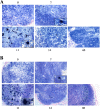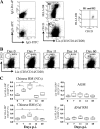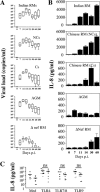Nonpathogenesis of simian immunodeficiency virus infection is associated with reduced inflammation and recruitment of plasmacytoid dendritic cells to lymph nodes, not to lack of an interferon type I response, during the acute phase
- PMID: 19939930
- PMCID: PMC2812402
- DOI: 10.1128/JVI.01496-09
Nonpathogenesis of simian immunodeficiency virus infection is associated with reduced inflammation and recruitment of plasmacytoid dendritic cells to lymph nodes, not to lack of an interferon type I response, during the acute phase
Abstract
Divergent Toll-like receptor 7 (TLR7) and TLR9 signaling has been proposed to distinguish pathogenic from nonpathogenic simian immunodeficiency virus infection in primate models. We demonstrate here that increased expression of type I interferon in pathogenic rhesus macaques compared to nonpathogenic African green monkeys was associated with the recruitment of plasmacytoid dendritic cells in the lymph nodes and the presence of an inflammatory environment early after infection, instead of a difference in the TLR7/9 response.
Figures






Similar articles
-
Blocking TLR7- and TLR9-mediated IFN-α production by plasmacytoid dendritic cells does not diminish immune activation in early SIV infection.PLoS Pathog. 2013;9(7):e1003530. doi: 10.1371/journal.ppat.1003530. Epub 2013 Jul 25. PLoS Pathog. 2013. PMID: 23935491 Free PMC article.
-
Downregulation of robust acute type I interferon responses distinguishes nonpathogenic simian immunodeficiency virus (SIV) infection of natural hosts from pathogenic SIV infection of rhesus macaques.J Virol. 2010 Aug;84(15):7886-91. doi: 10.1128/JVI.02612-09. Epub 2010 May 19. J Virol. 2010. PMID: 20484518 Free PMC article.
-
Primary infection with simian immunodeficiency virus: plasmacytoid dendritic cell homing to lymph nodes, type I interferon, and immune suppression.Blood. 2008 Dec 1;112(12):4598-608. doi: 10.1182/blood-2008-06-162651. Epub 2008 Sep 11. Blood. 2008. PMID: 18787223
-
Innate immune cell responses in non pathogenic versus pathogenic SIV infections.Curr Opin Virol. 2016 Aug;19:37-44. doi: 10.1016/j.coviro.2016.06.011. Epub 2016 Jul 20. Curr Opin Virol. 2016. PMID: 27447445 Review.
-
Dissecting the role of dendritic cells in simian immunodeficiency virus infection and AIDS.Immunol Res. 2011 Aug;50(2-3):228-34. doi: 10.1007/s12026-011-8220-3. Immunol Res. 2011. PMID: 21717075 Free PMC article. Review.
Cited by
-
Rapid progression is associated with lymphoid follicle dysfunction in SIV-infected infant rhesus macaques.PLoS Pathog. 2021 May 7;17(5):e1009575. doi: 10.1371/journal.ppat.1009575. eCollection 2021 May. PLoS Pathog. 2021. PMID: 33961680 Free PMC article.
-
A pathogenic role of plasmacytoid dendritic cells in autoimmunity and chronic viral infection.J Exp Med. 2019 Sep 2;216(9):1974-1985. doi: 10.1084/jem.20181359. Epub 2019 Aug 16. J Exp Med. 2019. PMID: 31420375 Free PMC article. Review.
-
Plasmacytoid dendritic cells in HIV infection: striking a delicate balance.J Leukoc Biol. 2010 Apr;87(4):609-20. doi: 10.1189/jlb.0909635. Epub 2010 Feb 9. J Leukoc Biol. 2010. PMID: 20145197 Free PMC article. Review.
-
Pathogenic Role of Type I Interferons in HIV-Induced Immune Impairments in Humanized Mice.Curr HIV/AIDS Rep. 2019 Jun;16(3):224-229. doi: 10.1007/s11904-019-00444-7. Curr HIV/AIDS Rep. 2019. PMID: 31055732 Free PMC article. Review.
-
Aged Chinese-origin rhesus macaques infected with SIV develop marked viremia in absence of clinical disease, inflammation or cognitive impairment.Retrovirology. 2018 Feb 1;15(1):17. doi: 10.1186/s12977-018-0400-y. Retrovirology. 2018. PMID: 29391069 Free PMC article.
References
-
- Abel, K., M. J. Alegria-Hartman, K. Rothaeusler, M. Marthas, and C. J. Miller. 2002. The relationship between simian immunodeficiency virus RNA levels and the mRNA levels of alpha/beta interferons (IFN-alpha/beta) and IFN-alpha/beta-inducible Mx in lymphoid tissues of rhesus macaques during acute and chronic infection. J. Virol. 76:8433-8445. - PMC - PubMed
-
- Amadori, M. 2007. The role of IFN-alpha as homeostatic agent in the inflammatory response: a balance between danger and response? J. Interferon Cytokine Res. 27:181-189. - PubMed
-
- Cella, M., D. Jarrossay, F. Facchetti, O. Alebardi, H. Nakajima, A. Lanzavecchia, and M. Colonna. 1999. Plasmacytoid monocytes migrate to inflamed lymph nodes and produce large amounts of type I interferon. Nat. Med. 5:919-923. - PubMed
-
- Choi, Y. K., B. A. Fallert, M. A. Murphey-Corb, and T. A. Reinhart. 2003. Simian immunodeficiency virus dramatically alters expression of homeostatic chemokines and dendritic cell markers during infection in vivo. Blood 101:1684-1691. - PubMed
Publication types
MeSH terms
Substances
LinkOut - more resources
Full Text Sources

